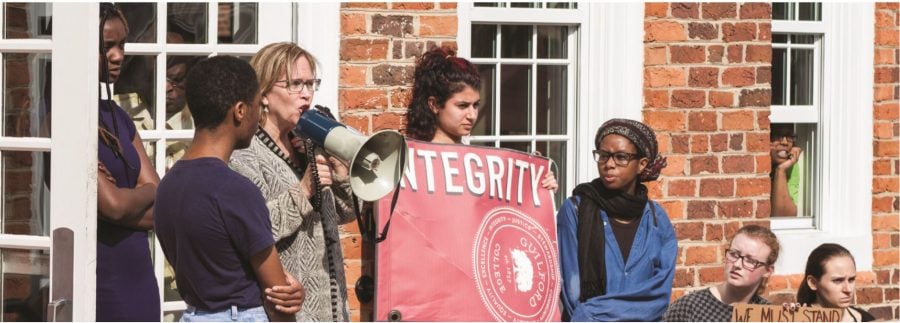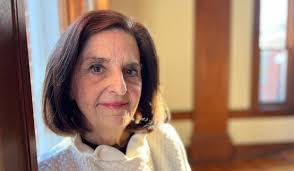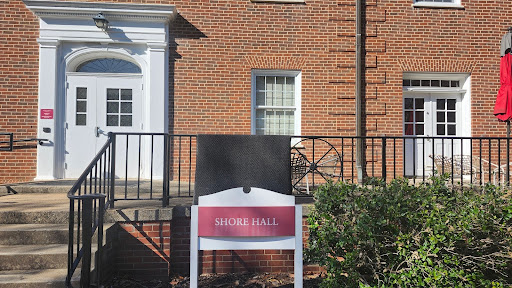One month later, the community is still divided
President Jane Fernandes addresses the crowd of students and protestors that gathered in response to an alleged sexual assault that was not properly handled on Wednesday, March 1, 2017 in front of Founders Hall. One month later, questions linger regarding the incident and the investigation. // Photo by Fernando Jimenez/Guilfordian
Almost a month after the initial incident, members of the Guilford College community are still divided on the events of Feb. 28 and March 1.
On the evening of Feb. 28, around 11 p.m. an anonymous student reported that a sexual assault had taken place between Hendricks and King Hall. According to the message to the community sent out by President Jane Fernandes, the student reporting asked if an alert would be sent out, and the Public Safety officer who answered the phone said yes.
A campus wide alert was not sent, however, until 1:24 a.m. The student who reported the alleged assault, who is black and trans, was mis-gendered several times by the director of Public Safety, William Anderson, who declined to comment for this article.
Around 1 a.m. a number of students gathered in solidarity with the student who had reported the assaulted and protest what they saw as Public Safety’s failure to adequately care for the student, or warn the community of the incident in a timely manner.
“I was doing homework, and my phone was on do not disturb, and at like 1 a.m. I took it off, and realized I had a text from my sister telling me to come to the P-safe office,” said first year Clare Chalkley. “I think (the protest) was important, because we’re still talking about it.”
The protest spread across campus and lasted well into the early hours of the morning — as late as 4 a.m. It included students creating posters about the incident, chalking sidewalks and walls, and marching through dorms while chanting, waking other students up.
Around 11 a.m. on March 1, Fernandes called together an ad-hoc group of people.
“(The ad-hoc group was to) try to get together with the people most impacted by the event, as well as some of the administration and faculty who could help,” said Fernandes. “And then we talked what had happened, and what our response would be. And we agreed we would meet again.”
Around 1 p.m. students gathered for another protest outside of Founders hall, carrying signs and chanting, calling for accountability and the firing of the Public Safety officers responsible. During the protest, some students cut and tore down the banners with the College’s core values printed on them.
“That protest was a lot, I think, and there are definitely parts of it that I thought were more successful than others,” said Chalkley. “(But) one of the parts of the protest on Wednesday I appreciated was tearing down the banners … you see a torn down banner, or a torn down poster, you’re going to ask questions.”
Several of the lead protestors did not respond to requests to comment.
Many members of the community felt, however, that the protest was too combative to lead to change.
“I think it was hard to see our campus community divided,” said Todd Clark, dean of students. “I was surprised — this was an act of sexual violence, and I wish that had been more central to the protest.” While there are no specific numbers at the moment, Clark estimated the total cost of the property damage from both protests, including the banners, was $1,000 to $2,000.
During the afternoon protest, both Fernandes and Anderson spoke, and were met with scepticism by students.
“(Fernandes) said the same thing over and over again,” said Chalkley. “I clearly didn’t expect her to fire anyone on the steps of Founders, and I don’t know that anyone in the protest expected her to do that, but realizing that she wasn’t going to do anything was kind of hard.”
After the protest, Fernandes met with a number of students, and then launched an inquiry, which led, eventually, to the letter to the community.
“ I guess I asked myself what led the students who were protesting to think that that was the only way or the best way to talk to us about what had happened,” said Fernandes. “I did learn things from the protest, so overall, I’m glad it happened, but I don’t know if that was the best way to get the desired outcome.”
Fernandes also asked the Greensboro Police department to increase patrols around campus in the immediate aftermath of the alleged assault, a response that drew criticism from many students given the department’s poor reputation among minority communities.
“We still had an alleged assailant (on campus),” said Fernandes. “I do understand that minority communities are in very tense relationships with law enforcement, and sometimes, as a deaf person, I am in a tense relationship with law enforcement, to be honest with you. But I thought it would be good to do something visible.”
Patrols have now returned to normal levels.
When the inquiry was finished, Fernandes met with the ad hoc group, Integrity for Guilford, and the senior team to announce the results.
“A lot of what I came to understand was not in alignment with what the protestors demanded,” said Fernandes. “We had a lot of, I guess, intense conversations about … But I’m glad that it was a much better conversation that we had there than we had at the protest.”









